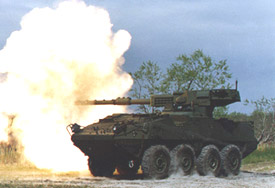Magazine (firearms): Difference between revisions
imported>Howard C. Berkowitz No edit summary |
imported>Howard C. Berkowitz No edit summary |
||
| Line 1: | Line 1: | ||
{{subpages}} | {{subpages}} | ||
'''Magazine''' is the name for a | '''Magazine''' is the name for a container where [[ammunition]] is stored. The term is used both for the container for immediate-use ammunition that is attached for to a gun, or for a storage area for ammunition of all forms. | ||
==Small arms magazine== | |||
The most common type of magazine for a rifle or pistol is a straight or curved metal box, which mechanically connects to a matching opening in the firing mechanism of the weapon. A spring in the bottom of the box pushes cartridges into the mechanism. The user fires until the magazine is empty, and then changes the entire magazine. | |||
More complex magazines for [[machine gun]]s are not spring-loaded, but contain a belt of linked ammunition, which is drawn into the gun by a feed mechanism driven by recoil, exhaust gas, or an electric motor. Depending on the design, the links are discarded before loading, or the cartridges are stripped from the belt and the empty belt fed out an exit port. | |||
==Field magazine== | ==Field magazine== | ||
| Line 14: | Line 19: | ||
[[Image:Prototype Mobile Gun System firing its autocannon.jpg|right|thumb|350px|{{#ifexist:Template:Prototype Mobile Gun System firing its autocannon.jpg/credit|{{Prototype Mobile Gun System firing its autocannon.jpg/credit}}<br/>|}} Prototype of the [[Mobile Gun System]], firing the cannon in its remote controlled turret. Note the magazine, which can hold 18 x 105mm rounds.]] | [[Image:Prototype Mobile Gun System firing its autocannon.jpg|right|thumb|350px|{{#ifexist:Template:Prototype Mobile Gun System firing its autocannon.jpg/credit|{{Prototype Mobile Gun System firing its autocannon.jpg/credit}}<br/>|}} Prototype of the [[Mobile Gun System]], firing the cannon in its remote controlled turret. Note the magazine, which can hold 18 x 105mm rounds.]] | ||
Most modern artillery uses a preloaded magazine similar to a [[Magazine (firearm)|firearms magazine]].<ref name=SfuMobileGunSystem-1> | |||
{{cite news | {{cite news | ||
| url=http://www.sfu.ca/casr/bg-mgs-project.htm | | url=http://www.sfu.ca/casr/bg-mgs-project.htm | ||
Revision as of 16:04, 15 February 2009
Magazine is the name for a container where ammunition is stored. The term is used both for the container for immediate-use ammunition that is attached for to a gun, or for a storage area for ammunition of all forms.
Small arms magazine
The most common type of magazine for a rifle or pistol is a straight or curved metal box, which mechanically connects to a matching opening in the firing mechanism of the weapon. A spring in the bottom of the box pushes cartridges into the mechanism. The user fires until the magazine is empty, and then changes the entire magazine.
More complex magazines for machine guns are not spring-loaded, but contain a belt of linked ammunition, which is drawn into the gun by a feed mechanism driven by recoil, exhaust gas, or an electric motor. Depending on the design, the links are discarded before loading, or the cartridges are stripped from the belt and the empty belt fed out an exit port.
Field magazine
It is important to protect the ammunition from the fire of one's antagonist's weapons, and from the effects of a malfunction of one's own weapons. So, if possible, it is desirable to armour the magazine. In the case of batteries of towed artillery the temporary magazine will be placed, if possible, in a pit, or natural declivity, or surrounded by sandbags or earthworks.
Historically, when artillery was powered by gunpowder, a vessel's magazine would be kept below water level. The gunner and his mates would wear felt slippers, or bare feet, to prevent sparks. The door to the magazine would be a wet, felt curtain. Light would be provided through a window, from an adjacent room. A naked flame was never allowed inside the magazine.
More modern warships used semi-automated or automated ammunition hoists for their main batteries. The path through which the weapon's ammunition passed would have blast-resistant airlocks.
Autoloaders

Prototype of the Mobile Gun System, firing the cannon in its remote controlled turret. Note the magazine, which can hold 18 x 105mm rounds.
Most modern artillery uses a preloaded magazine similar to a firearms magazine.[1]
References
- ↑ Background — Canadian Forces Mobile Gun System (MGS) Project, Canadian American Strategic Review. Retrieved on 2008-04-21.